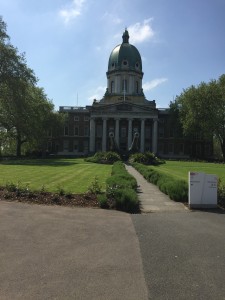The last portion of our study tour was spent in the city of Berlin, Germany. Immediately, I got a feeling for the immense culture throughout the city, just by viewing all the graffiti, people, and buildings through the window of the bus. Once off the bus, I was able to immerse myself into the Berlin culture, and absolutely fell in love.
The graffiti was unlike anything I have ever seen. It was not just your everyday, run of the mill graffiti, but an actual art form. An example of this was along the longest standing portion of the Berlin Wall, known as the East Side Gallery. Each portion had a different illustration from different artists. Each painting was so different, yet somehow they all ran so fluidly together.
Not only did I love the street art, but I also loved the street food. On the first night in Berlin, our professors took us to a traditional German restaurant, which was absolutely delicious. Having German heritage, I was no stranger to pork and sauerkraut, but this meal was much better than anywhere in the states. Aside from this meal, my diet mostly consisted of bratwurst and currywurst from little roadside stands. These brats were quick, easy, and undeniably delicious.
While in Berlin we visited many German and Soviet museums and memorials. It surprised me how objective the German museums were, as opposed to the other museums we have seen in London, France, and Poland. The museums such as the Topography of Terror Museum and the German Resistance Museum simply stated the facts, as opposed to being blatantly one sided. Not only were these places objective, but it also surprised me how accessible they made the memorials and museums. This goes to show how trusting the German culture is, and also how they have taken responsibility for their past. School age children are required to visit a certain amount of Holocaust and war related sites in order to complete their curriculum, which I think is a great way to educate the German people about the events of the war. Another difference I noticed between German museums and others I have seen on the trip so far was that they were largely text based. Museums I had seen up until Germany were largely based on pictures and physical items, so while walking through museums, I wouldn’t see a large wall of pictures or war souvenirs, but a large wall of text that was occasionally accompanied by a few pictures.
Ohio State’s motto is “Education for Citizenship.” I believe that from my experiences here in Berlin, and throughout this trip, I have gained a worldly perspective that I would have never been able to get if it weren’t for the amazing people, places, and professors that I had the opportunity to learn from these past three weeks. The knowledge I have gained from this study tour, both about myself and about World War II, are not something that can be taught from a classroom, but are things that needs to be felt and experienced. I have come out with life long friendships, and a greater understanding of where I fit in this larger than life world. This trip has been everything I thought it would be and more, and I could not be more thankful.
Danke,
Amelia









